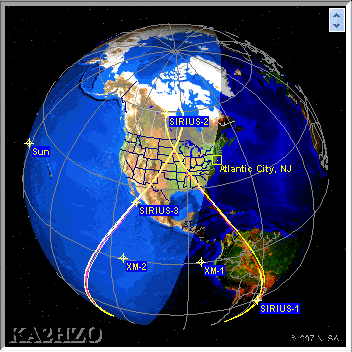The last time I blogged about satellites, it was related to Amateur (ham radio) satellites. Yesterday I read a news story about a company called World Space that had just raised a lot of money for a broadcast radio satellite system in Europe, Africa, and Asia similar to those used by XM and Sirius in North America. The man behind World Space is Noah Samara and he is a key figure in satellite radio development. I looked him up on Google and found that he had graduated from East Stroudsburg State College in Pennsylvania. I know this because he was asked to come back and give a commencement speech and I must say that it’s one of the best commencement speeches I’ve read.
I’ve always been intrigued by these new radio broadcast satellites, since I know the challenges and limitations of satellite communications and I’m pretty sure I would have been one of the people who would have questioned the technical and logistical feasibility of such a business model had I been asked for my opinion, say around 1990, when Noah started his company. And it sounds like I wouldn’t have been alone. It’s a good thing that people persevere in spite of the experts’ opinions.
I’ve been toying with the idea of getting a satellite radio, one that I could move between my car, motorcycle, and airplane and so I wanted to figure out the difference between the two approaches used by Sirius and XM. In the case of XM, they use standard geo-synchronous satellites which are located in the Clark belt, which is a ring aligned with the equator about 24,000 miles from the earth. Most communication satellites are in this location because it allows them to be weightless as they rotate with the earth. Their centripetal force exactly cancels out the gravitational pull of the earth. Therefore, they need to use little fuel to stay positioned. It’s a good thing too, since a satellite’s life expectancy is around 15 years and there are no refueling stations in the Clark belt. This also gives them the advantage of staying in one location, so high gain dish antennas can be used which means they don’t have to transmit their signal with as much power (power is also a scarce resource in space). However, that advantage is lost with satellite radio because in a mobile environment, you can’t expect to keep a highly directional dish antenna pointed at the satellite.
If you click on the image above, you’ll get a larger image which makes it easier to see all of the man-made satellites orbiting the earth in the Clark belt. If you look closer to the globe, you can see the low-earth orbiting satellites, which orbit the earth approximately every 100 minutes, flying just a few hundred miles above the surface. These are satellites used to take images such as the spy satellites and weather satellites. If you would like to see where these images came from, visit the J-Track website sponsored by NASA and select Jtrack 3D. It requires a Java applet to be downloaded to your computer, but the results are definitely worth it. You can rotate the whole image around and view these satellites from every angle.
Sirius uses a completely different approach. They use an elliptical orbit that allows the 3 satellites to spend more time directly overhead since in North America geosynchronous satellites have a low angle and can be more easily blocked by buildings, or even a passing truck.
You can see from the animation above that there is always at least one satellite over the U.S. at all times. The orbit for each satellite takes about a day.
Both companies use ground-based repeaters to help overcome the inevitable dead spots created by obstructions, but this only needs to be done in a relatively small number of urban locations. Sirius, because of the less obstructed view of the satellites needs fewer repeaters.
If you are interested in comparing the two satellite radio companies to see the features of their respective products, there is a nice chart of it here.


